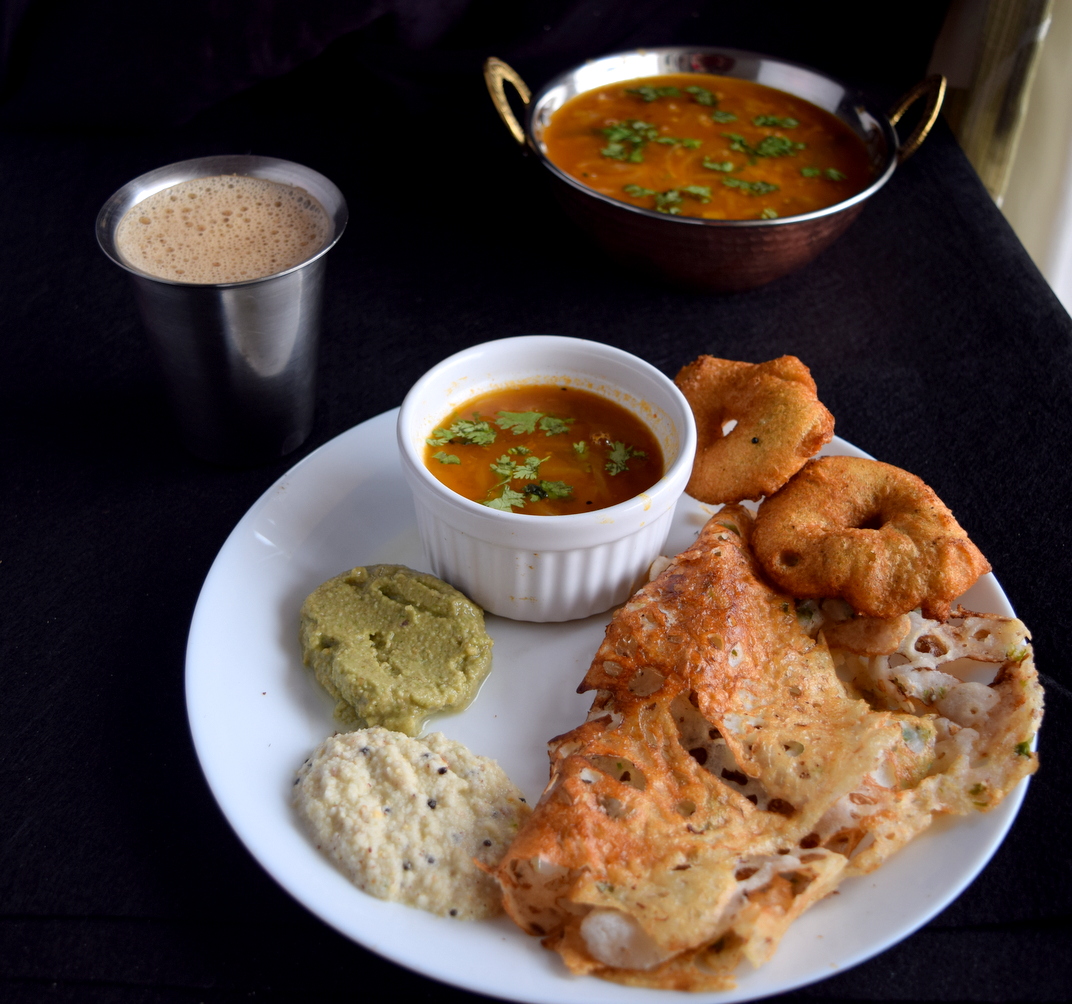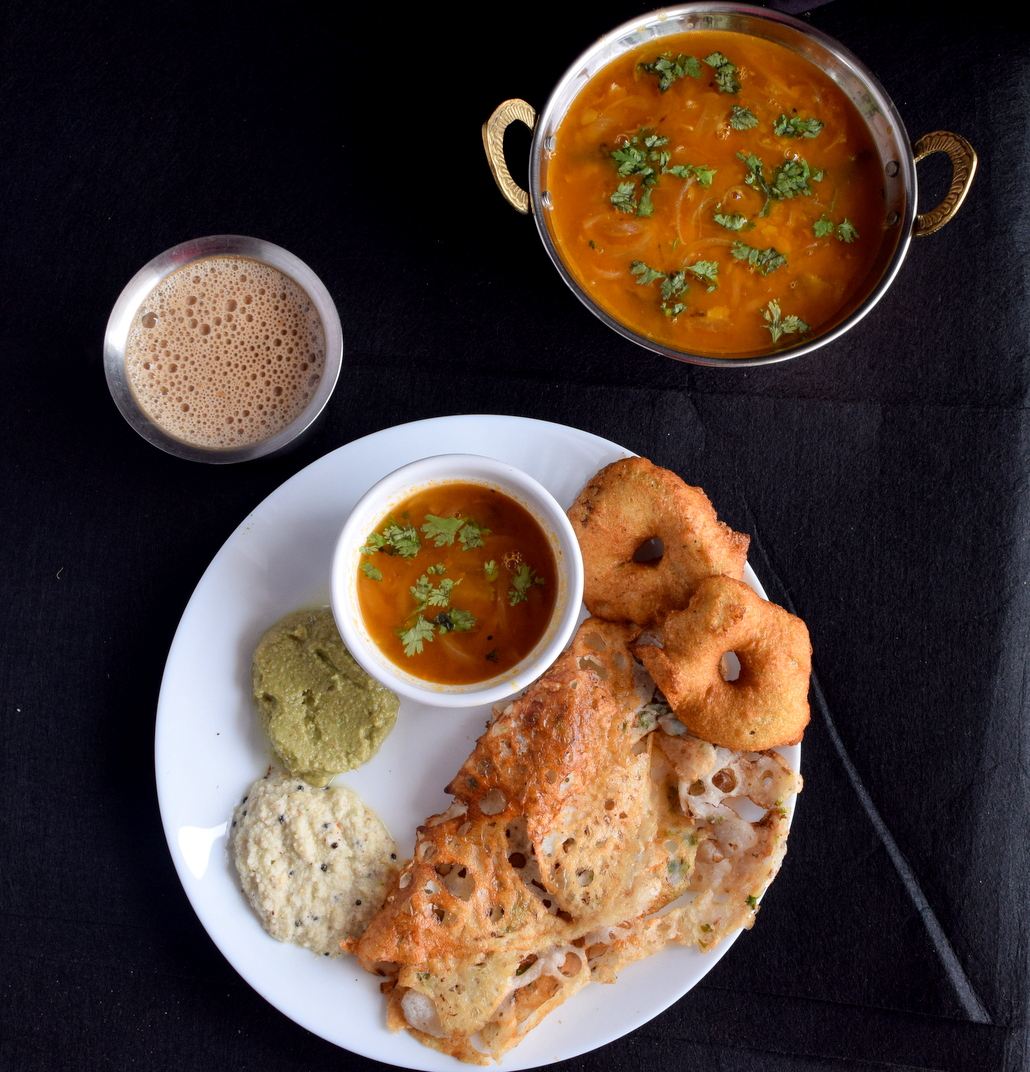
In the second of my Weekend Breakfasts, I have the most delicious Rava Dosa with the classic partner, medhu vadai. They are accompanied by sambhar and two types of chutneys – coconut and coriander. All of this has to be washed down with a tumbler full of frothy, steaming filter coffee.
I have tried numerous recipes for the rava dosa and most of them have simply not worked. Either the dosa would come out in bits and pieces as if it has been toyed around by a toddler or it would stick strongly to the tava and simply refuse to budge. I kept experimenting with various types and quantities of rava and rice flour. Finally I can tell you that I have a nearly foolproof recipe for the rava dosa. It is no longer something I can only have at a restaurant. I can have it whenever I feel like it, which is way more often than it should be. I love this recipe and this dish so much that I am convinced this is my legacy. Whatever I do or don’t do henceforth, I am happy to report I can make a good Rava Dosa.

Simple Ingredients Fabulous Results
The basic recipe has mainly three ingredients – rava / semolina, rice flour and curds. There are some simple thumb rules to go by. The time needed to soak the rava in curds is directly proportional to the proportion of rava in the recipe. The more rava in the recipe, crispier is the dosa and the skill needed is also more.
The all important ratios
The usual proportion is 1/2 cup of rava to 1/2 cup of curds and 1 cup of rice flour. You can use as low as 1/4 cup of rava & curds each to 1 cup of rice flour. An equal amount of rava and rice works but I prefer the taste and texture when rava is half the rice flour. Though you can substitute part of the curd with water I would recommend you not to do that.
Using equal amount of rava and curds is one of the key reasons for success in making this dosa.
Mix the rava and curds together and set aside before adding the rice flour. If you use only 1/4 cup then you need only 10 minutes of soaking for the rava. If you are using more, then you would need around 20 minutes. You can play around with this depending on the time available to you.
Sour curd vs Fresh curd
If the curds are sour the dosa tastes better but you can make this with fresh curds. If you are in a cool climate then keep the curd out at night. It will be slightly sour by morning and perfect for the dosa.
It is important to have the curds at room temperature. If you don’t have it, then take the required curds in a separate bowl and add few spoons of boiling water to it. This will help increase the temperature of the curds.
How much Water?
The amount of water to be used depends on the quality of rava. To check if you have sufficient water is to pour a small amount of batter on a very hot tava. If it does not immediately form a lace like pattern, then you may need to add more water. But only add 1-2 spoons each time so that you do not end up with excessive water in the batter.
The tava needs to be very hot while pouring the batter. As soon as you pour the batter, reduce the flame slightly and to low flame once you turn over the dosa. This will ensure the tava is not overheated and is in perfect temperature for the next dosai.
Rava Dosa

Receip for the crowd pleasing rava dosa with lots of tips and tricks
- 1/4 cup Rava / Semolina
- 1/4 cup Curds / Yogurt
- 1/2 cup Rice flour
- 1 tsp Jeera / cumin seed
- 1 tsp Kali mirch / Black pepper, freshly ground
- 1 tbsp Fresh coriander, finely chopped
- 1-2 tsp Cashewnuts, broken
- Salt
- Water
- Oil, to cook the dosa
In a large vessel, mix the rava and curd to ensure that no dry rava remains. Set aside for 30 minutes, at least
At the end of the 30 minutes, the rava would have absorbed most or all the curd and become a thick mix. Add the rice flour, cumin, pepper, cashew and salt.
Add around 2 cups of water and mix to yield a runny batter. If needed, add some more water to get a runny consistency to the batter
Heat a cast iron tava till it is nicely hot. Use a slice of onion or silicon brush to spread some oil on the tava. This step is essential for beginners
Pour a ladle full of batter first as an outline and then fill inside the outline. If the tava is sufficiently hot and the batter is properly runny then it will immediately form a lace-y pattern on the tava
The dosa needs to be like the right half of the dosa in this picture, lacey and beautiful. If you dosa turns out like the left side of the picture then it means that the tava is not hot enough. If your tava is hot enough then try adding a little more water to the batter.

After pouring the batter, add a few drops of oil around the dosa and reduce the heat. Once the edges of the dosa turn slightly brown, then use a steel spatula to disengage the dosa from the tava and turn it over
The rava dosa will take longer than the regular dosa to get cooked. So wait for a minute or so before trying to take it out. Once the dosa has been turned over, wait for about 20-30 seconds before taking it off the tava to a plate.
Repeat the same procedure with the rest of the batter
Enjoy your rava dosa with chutney sambhar or molagapodi/ idli gunpowder
- You can add finely chopped onions to the tava before pouring the batter to make onion rava dosa
- You can use ghee / clarified butter instead of oil to make ghee rava dosa
- You can make some potato masla and enjoy it as rava masala dosa
- Flat based cast iron tavas are best to make rava dosa or any type of dosa. Try and avoid non stick tava for dosas because they become dry.
- This recipe can easily be doubled or tripled as needed

This is my post for the Blogging Marathon under ‘Weekend Breakfasts’.
Check out the Blogging Marathon page for the other Blogging Marathoners doing this BM


Nicely done !!
LikeLike
Delicious dosa with all the chutney sevings sambar Vada.. Rava dosa is always special and having got it perfect deserves a big thumbs up 🙂
LikeLike
The whole platter is so tempting. I am going to try the dosa soon.
LikeLike
Wow ! Loved your take on the dosa . I will come back again to re read and grasp it well . I have planned Dosa’s for Sunday Lunch , will be trying these too and will let you know how they come out .
LikeLike
Like your detailed explanation as to how to make a lacy rava dosa. I’ve tried to make them at home and have failed. Bookmarking your recipe to try it out.
LikeLike
I recently learnt making instant rava dosa from a South Indian friend. It comes out great too. Your version is a bit different from hers. Bookmarking this to try. I am a Rava Dosa Fan
LikeLike
Simple and easy recipe. I know it tastes great.
LikeLike
I had this delicious breakfast when I was in India last year and yours is reminding me of it
LikeLike
I am hungry now Sowmya! That platter looks so tempting. You have explained the method so well!
LikeLike